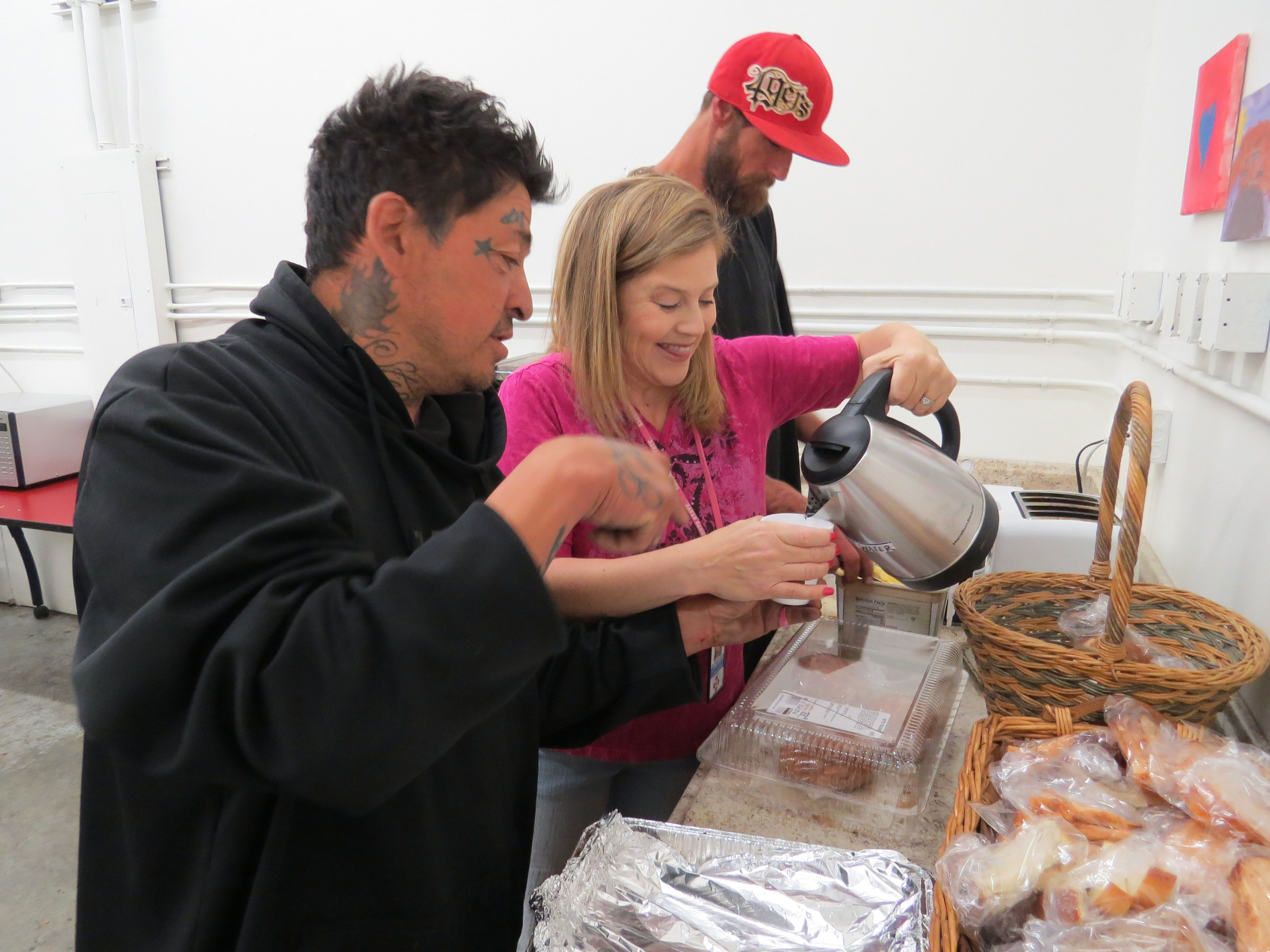Published in the October 10 – 23, 2018 issue of Morgan Hill Life

Photo by Marty Cheek
Lisa Dimas-Jessen, director of operations for the Compassion Center, pour coffee for Armando “Monster” Villarreal. Christopher “Too Tall” Harris, helps himself to a bagel.
If California happened to be a country, it would have the sixth largest gross domestic product in the world. That means it would be slightly ahead of France. However, as the Golden State’s economy has grown, so has income inequality — especially here in Santa Clara County.
According to the U.S. Department of Housing and Urban Development, California accounts for nearly half of all the unsheltered people in America. And because of the Bay Area’s high expenses for housing, many of the workers on the lower end of the income scale are not able to afford to rent homes. Many people are now living in RVs in parking lots at the companies they work for or on city streets. And in our county, among the more than 7,000 homeless individuals, 74 percent are unsheltered. Often, they find themselves living in tents in encampments in the riparian areas along creeks flowing through urban areas that are the property of the Santa Clara Valley Water District.
The SCVWD staff met Aug. 21 in a joint meeting with city councilmembers Rene Spring of Morgan Hill and Dion Bracco of Gilroy representing these South Valley cities. They discussed the challenges of homelessness living along South Valley’s creeks. The problem is a complex one involving finding solutions for the quality of life of these human beings and the stewardship of the creeks and our water resources.
 There is a heavy impact on the environment from the homeless, including bank excavation, erosion, fire danger, hazardous material and bio-waste contaminating the water supply. There are also impacts on the fish and wildlife when homeless people poach or their behavior and waste destroy habitats.
There is a heavy impact on the environment from the homeless, including bank excavation, erosion, fire danger, hazardous material and bio-waste contaminating the water supply. There are also impacts on the fish and wildlife when homeless people poach or their behavior and waste destroy habitats.
Last year, the water district removed 907 tons of trash and debris from encampment sites in Santa Clara County. And as the county’s population increases as more people come here with promises of good jobs in the high-tech industry, rents will continue to rise with increased competition for homes and apartments. That means the homeless number will likely grow. For the first seven months of 2018, the water district crews cleaned-up 571 homeless camps along the county’s creek, surpassing the year average clean-ups of about 400 camps.
The water district works in partnership with the cities of San Jose and Gilroy in the encampment cleanup efforts. The district provides crews, supplies, equipment and the regulatory permits for the job. The cities provide the 72-hour notifications to the people of the encampments to prepare them for the clean-up. The cities also provide site security and the collection and storage of personal property.
In Gilroy, two police officers go into the encampments on Llagas Creek before the water district crew arrives and make sure they are safe. The city’s taxpayers paid about $32,000 in overtime so far this year for the police presence, which is vital for the protection of those who might face angry homeless people when they clean-up tarps, sleeping bags and other items. Jan Bernstein Chargin, executive director of the Gilroy Compassion Center, said that some homeless people have had personal belongings forever lost in these clean-ups of the creeks.
In 2012, voters approved Measure B, a special parcel tax called the Safe Clean Water and Natural Protection Program that has a sunset date of June 30, 2028. It provides $8 million in funding targeted toward encampment creek cleanup efforts — with an aim of 52 cleanups a year. Two years after the measure passed, there were 131 cleanups — and the number keeps growing. The extensive demand for creek cleanups has severely impacted the budgeted funding for the program. Two years ago, the water district board formed a Homeless Encampment Ad Hoc Committee to deal with the challenges of balancing stewardship with the human element of finding some shelter in an area with high rent prices.
Silicon Valley’s homeless issue is not an easy problem to solve. Of some help is Measure A — the $950 million affordable housing bond approved by county voters in November 2016. And innovative ideas like “tiny houses” can also help to alleviate the problem.
Hopefully, someday a real solution to this housing crisis will be found.
We encourage residents of South Valley to see the homeless with compassionate eyes and treat them with kindness. It’s not unrealistic to imagine that with the misfortune of an expensive medical issue or the loss of a job, anyone can find themselves one day in their place.






